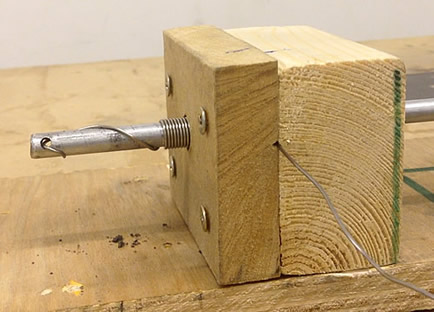Calculations
To make lifge easier, I've provided a Coil Making Calculator that will do much of the folowing maths for you. But for those interesting in number crunching, let's start with Power.
POWER
Physics gives us the formula P = IV (power = current x volts). So let's say the Voltage is 230 and the current is 10 Amps. This would give us a potential power rating of (230 x 10) 2300 Watts (2.3 KW).
Physics also gives us another useful Power formula which is P = I²R (Power = Current Squared x Resistance). So let's say our current is still 10 Amps and our resistance is 23 Ohms. This would give us a potential power rating of (10² x 23) 2300 Watts (2.3 KW).
VOLTAGE
If we don't know the voltage, we can turn to Ohms Law formula V = IR (Voltage = Current x Resistance). So with current of 10 Amps and resistance of 23 Ohms we could establish, in this example, a voltage of (10 x 23) 230 Volts.
RESISTANCE
If the resistance of a circuit is unknown, we can again turn to Ohms Law and rearrage the formula to give us R = V / I (Current = Volts / Resistance). So as an example, Volts of 230 divided by a Current of 10 Amps gives us (230 / 10) 23 Ohms.
Where could also rearrange the Power formula to calculate resistance, ie R = P / I² (Resistance = Power / Current Squared). So as an example, Power is 2300 Watts divided by a Current of 10 Amps squared gives us (2300 / 10²) 23 Ohms.
CURRENT
Just as with resistance, we can use Ohms Law and rearrage the formula to give us current with I = V / R (Current = Volts / Resistance). So as an example, Volts of 230 divided by a resistance of 23 Ohms gives us (230 / 23) 10 Amps.
Rearrange the Power formula to calculate current with I² = P / R (Current Squared = Power / Resistance). So as an example, Power is 2300 Watts divided by a resistance of 23 Ohms gives us (2300 / 23) 100 Amps - and when we get the square root of this it gives us 10 Amps.
WIRE LENGTH
The last thing we need to consider is the length of the wire. If you're making a coil, you'll need to calculate the resistance needed and from that it's a simple matter of calulating the length. L = R / r (which is a terrible made up formula meaning Length = Resistance / Resistance per unit length). For example, we know our resistance is 23 Ohms and I mentioned earlier the given resistance per meter on my wire is 1.73 Ohms (23 / 1.73) which gives us a length of wire of 13.2 metres required.
Online Calculator
To make lifge easier, I've provided a Coil Making Calculator that will do much of this maths for you. To use it, click here.
Stretching The Coil
One last thing - before using the coil it must be stretched. If you fail to stretch it you've basically got a solid length of metal with no resistance.
Stretching is easy enough. Simple securely grab each end and pull. You may need to do this a few times. It's generally considered a bad idea to stretch the coil longer than three times its original (unstretched) length.
 Whilst I was making an electric foundry, I realised I needed resistance heating coil elements - those spring like things you see in old electric fires. Now these are cheap enough on the internet but I believe you get what you pay for and I wanted to use superior Kanthal wire. As such I came up with a very simple jig that anyone can make from a couple of scraps of wood.
Whilst I was making an electric foundry, I realised I needed resistance heating coil elements - those spring like things you see in old electric fires. Now these are cheap enough on the internet but I believe you get what you pay for and I wanted to use superior Kanthal wire. As such I came up with a very simple jig that anyone can make from a couple of scraps of wood.
 COIL : A coil is a length of wire wrapped in tight circles. The purpose of the coil is to reduce the apparent length of the wire. The resistance wire involved in a coil may be surprisingly long but by coiling it, it's possible to dramatically shorten the eventual length. For example, I made a coil containing 7 meters (23 feet) of wire, but the coil itself was quite short, maybe 15cm (6 inches) or so. That's quite a space saving and this allows the effects of the wire to be concentrated in a smaller area.
COIL : A coil is a length of wire wrapped in tight circles. The purpose of the coil is to reduce the apparent length of the wire. The resistance wire involved in a coil may be surprisingly long but by coiling it, it's possible to dramatically shorten the eventual length. For example, I made a coil containing 7 meters (23 feet) of wire, but the coil itself was quite short, maybe 15cm (6 inches) or so. That's quite a space saving and this allows the effects of the wire to be concentrated in a smaller area.